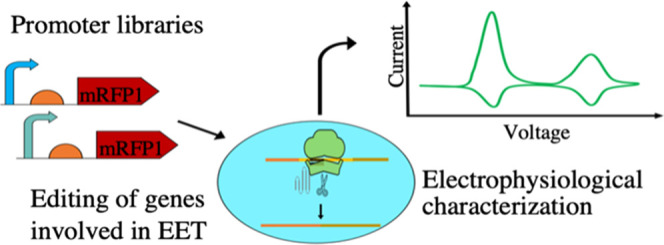- Record: found
- Abstract: found
- Article: found
Synthetic Biology Toolbox, Including a Single-Plasmid CRISPR-Cas9 System to Biologically Engineer the Electrogenic, Metal-Resistant Bacterium Cupriavidus metallidurans CH34

Read this article at
Abstract

Cupriavidus metallidurans CH34 exhibits extraordinary metabolic versatility, including chemolithoautotrophic growth; degradation of BTEX (benzene, toluene, ethylbenzene, xylene); high resistance to numerous metals; biomineralization of gold, platinum, silver, and uranium; and accumulation of polyhydroxybutyrate (PHB). These qualities make it a valuable host for biotechnological applications such as bioremediation, bioprocessing, and the generation of bioelectricity in microbial fuel cells (MFCs). However, the lack of genetic tools for strain development and studying its fundamental physiology represents a bottleneck to boosting its commercial applications. In this study, inducible and constitutive promoter libraries were built and characterized, providing the first comprehensive list of biological parts that can be used to regulate protein expression and optimize the CRISPR-Cas9 genome editing tools for this host. A single-plasmid CRISPR-Cas9 system that can be delivered by both conjugation and electroporation was developed, and its efficiency was demonstrated by successfully targeting the pyrE locus. The CRISPR-Cas9 system was next used to target candidate genes encoding type IV pili, hypothesized by us to be involved in extracellular electron transfer (EET) in this organism. Single and double deletion strains (Δ pilA, Δ pilE, and Δ pilAE) were successfully generated. Additionally, the CRISPR-Cas9 tool was validated for constructing genomic insertions (Δ pilAE::gfp and Δ pilAE::λ Pr gfp). Finally, as type IV pili are believed to play an important role in extracellular electron transfer to solid surfaces, C. metallidurans CH34 Δ pilAE was further studied by means of cyclic voltammetry using disposable screen-printed carbon electrodes. Under these conditions, we demonstrated that C. metallidurans CH34 could generate extracellular currents; however, no difference in the intensity of the current peaks was found in the Δ pilAE double deletion strain when compared to the wild type. This finding suggests that the deleted type IV pili candidate genes are not involved in extracellular electron transfer under these conditions. Nevertheless, these experiments revealed the presence of different redox centers likely to be involved in both mediated electron transfer (MET) and direct electron transfer (DET), the first interpretation of extracellular electron transfer mechanisms in C. metallidurans CH34.
Related collections
Most cited references61
- Record: found
- Abstract: found
- Article: not found
Development and applications of CRISPR-Cas9 for genome engineering.
- Record: found
- Abstract: found
- Article: not found
Extracellular electron transfer via microbial nanowires.
- Record: found
- Abstract: not found
- Article: not found